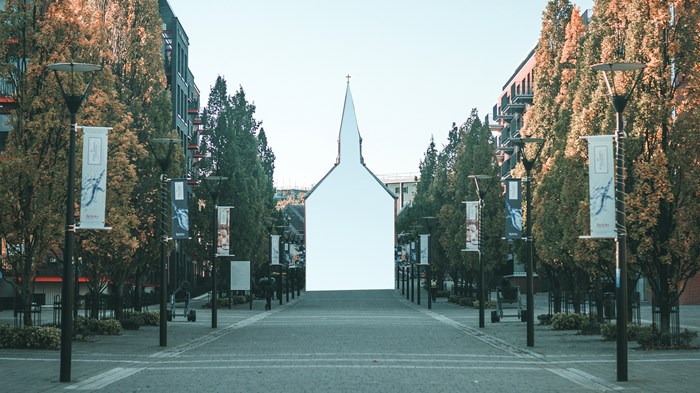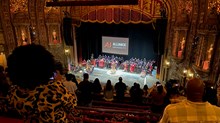
The future looked bleak for St. Peter’s United Church of Christ (UCC) in Louisville, Kentucky. The congregation had dwindled to a dozen elderly German Americans in a poor, predominantly Black neighborhood. Their building was falling apart.
Despite its façade of stained glass and majestic steeples, all the building systems were failing, including plumbing, electrical, and heating. Plaster was falling off the walls and ceiling. The city eventually closed the building due to its dangerous lead paint.
But thanks to the vision of pastor Jamesetta Ferguson and a partnership with the UCC’s Church Building and Loan Fund, the church’s property now houses a thriving multiuse development known as The Village at West Jefferson. It has injected life into the local economy—and the formerly dying church.
With funding from multiple mainline denominations, private investors, the city of Louisville, and the federal government, St. Peter’s erected a complex that includes a coffee shop, a credit union, a daycare center, health care services, and more. Hundreds use it weekly. Plus, the congregation is up to 160, with a “multi-cultural, multi-generation” membership.
“The community has really been renewed in many ways,” said Patrick Duggan, executive director of the Church Building and Loan Fund. St. Peter’s “is doing the work of serving the poor. In the meantime, it has created about 100 jobs. This is not just talking the talk. It’s actually walking the walk.”
Similar multiuse developments are popping up across North America on the properties of formerly dying churches—most of them in mainline Protestant denominations.
A Montreal Anglican church shares space with a nonprofit circus company and a refugee advocacy group among other organizations. The mixed-use development at Emory Fellowship in Washington, DC, includes affordable housing. So does the development spawned by Arlington Presbyterian Church in Virginia.
The challenge of declining congregations in big buildings won’t go away anytime soon. Each year, church closures outnumber new church starts in America by 50 percent, according to Lifeway Research. In 2019, prior to the pandemic, although about 3,000 new churches opened, 4,500 closed. Five years earlier, Lifeway’s analysis showed church openings outpaced closings 4,000 to 3,700.
Church closures are predicted to snowball. In 2021, the percentage of Americans holding membership in a house of worship dropped below 50 percent for the first time in history, the Gallup organization found. The median church size in 2020 had fallen to less than half of what it was in 2000—from 137 to 65.
Such data has spawned a dire prediction by Presbyterian researcher Eileen Lindner: By 2025, 100,000 North American churches could close their doors.
“Over and over, I have experienced congregations of 10 or 50 or perhaps 100 in buildings that would host 500 or 1,000,” said Rick Reinhard, principal consultant with Niagara Consulting Group. “It’s great to pray. It’s great to hire charismatic pastors. But for the most part, those churches are not going to come back.”
With declining churches, it’s not that certain parts of the facility are utilized while others sit unoccupied. The entire building is underused or unused, Reinhard said. “The $7–$10 per square foot per year it costs to operate church properties will sink” most congregations with big buildings and small crowds.
For example, a church that had 500 people in its 50,000-square-foot facility in 1970 may have dwindled to 30 elderly people today. Building operations alone would necessitate annual giving of nearly $17,000 per attendee. The math doesn’t work.
But is transforming a church building into a community development hub a valid way to fulfill Jesus’ Great Commission? Yes, says Shannon Hopkins of Rooted Good, a group that helps faith-based organizations align their mission and their money. She’s worried that if declining churches resort to selling their buildings rather than repurposing them, America will miss out on a flood of missional impact.
House-of-worship closures in the coming decades could yield “the greatest reshaping of American communities since the GI Bill,” Hopkins said. “This is a time of hope. While a lot of the narrative is about decline,” the present “is a really unique moment of opportunity.”
Churches across the country are seizing the opportunity. That includes congregations in rural and urban settings, with the setting determining how they repurpose. While dying urban churches may repurpose into affordable housing, rural Ottumwa, Iowa, has seen eight churches close in recent years. Three have repurposed into a creative arts space, a medical office, and a residence.
Among congregations assisted by Rooted Good, an Alabama church is starting an economic development zone from one of its buildings. In San Antonio, a declining church aims to transform its facility into a park and outdoor amphitheater while meeting for worship in a nontraditional, dinner church setting (where worship occurs over a meal rather than in a sanctuary).
In the next 50 years, up to half of US churches will repurpose their buildings, Hopkins said.
Mark Clifton isn’t sure that’s a good idea. As senior director of replanting for the North American Mission Board of the Southern Baptist Convention (SBC), he wants church buildings to remain church buildings—housing replanted and revitalized congregations. His view represents an evangelical counterapproach to mainline denominations’ repurposing strategy.
Closing churches “robs God of his glory,” Clifton said. “What about a dying church says our God is great and his gospel is powerful?” The church “is not a store. It’s not a restaurant. It’s not a mall. It’s the bride of Christ. It’s worth fighting and battling to keep those churches going as a testimony to the power of the gospel.”
When a dying church seeks assistance from Clifton, he helps them choose from among three paths:
- A new church plant could adopt the old church’s building and bring its members into their new congregation.
- A healthier church could adopt the dying church and work to plant a new congregation in its building.
- The dying church could hire a pastor with training to replant the church from within. That pastor would shepherd the remaining members and work to transform them into a vibrant church once again.
Clifton practices what he preaches. Three years ago, he became pastor of the three-member Linwood Baptist Church, 35 miles from Kansas City. The members wanted to sell the building and close, but Clifton convinced them to try something different. Today they have 115 in worship and have baptized more than 20 new believers over the past three years.
It may be wise to let groups in the community use a declining church’s building, Clifton said, but as an outreach rather than a repurposing or an attempt to raise capital.
Others say a replant isn’t always feasible. The Cooperative Baptist Fellowship (CBF), a group that formed in the 1990s as a protest against the SBC’s conservative direction, has researched the ways churches can utilize their properties to generate additional income. Its case studies feature churches dabbling in solar farming, paid-parking facilities, preschool programs, and neighborhood outdoor space among other options.
“Often out of the necessity to be better stewards of their real estate and to enlarge their financial base, these churches have discovered needed energy through more regular use of their buildings,” the CBF states on its website. Repurposed churches “have forged new friendships with entities now using their space” and “have also seen their financial situation improve significantly through the income generated by these creative ventures.”
The difference between conservative and progressive denominations’ approaches to declining churches boils down to theology, said Duggan of the UCC. Conservatives generally think redeveloping church buildings represents a secular or political approach. They emphasize gospel preaching and evangelism. Progressives may draw from theological traditions like liberation theology and the thought of Walter Brueggemann to emphasize community development and affordable housing.
“It really has to do with the vision of who Jesus is and what the church is supposed to be,” Duggan said.
Despite the difference of opinion on what to do with declining churches’ buildings, one fact draws universal agreement: A fresh strategy for them must emerge.
“The future,” Reinhard said, “is not a stand-alone church with a fence around it, divided from the neighborhood, isolated from the neighborhood.” Something has to change.
David Roach is a freelance reporter for CT and pastor of Shiloh Baptist Church in Saraland, Alabama.

Support Our Work
Subscribe to CT for less than $4.25/month








